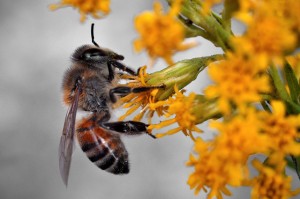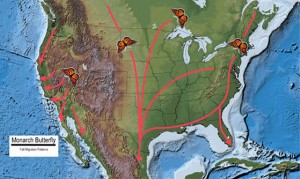With spring in the air, MEC is shaping a plan to protect pollinators

Editor’s note: This post is by MEC intern Teha Ames.
A serious problem that should not be overlooked by the state of Michigan and its residents is the decline of pollinator populations. Pollinators include bees, butterflies, beetles, hummingbirds and other animals that help flowering plants reproduce by transferring pollen from plant to plant. Pollinator population declines have been linked to habitat loss, parasites, pathogens, pesticide exposure, climate change and other factors. A global assessment of pollinators published in February found a growing number of pollinators are threatened with extinction.
The services pollinators provide are essential for feeding the world and for supporting agricultural jobs. In 2014, President Obama issued a memorandum highlighting why honey bees and other pollinators are important in the United States. “Honey bee pollination alone adds more than $15 billion in value to agricultural crops each year in the United States,” it noted. The memorandum also established a Pollinator Health Task Force between several government agencies to combat the problem. In its 2015 strategy to protect pollinators, the task force laid out three clear nationwide goals: reduce honey bee colony losses during winter to no more than 15 percent within 10 years; increase the eastern population of monarch butterflies (which includes Michigan’s monarchs) to 225 million by 2020; and restore or enhance 7 million acres of land for pollinators over the next 5 years.
Since Obama issued the memorandum, several states have joined the fight for pollinator protection. One state that has not created a pollinator protection plan yet is Michigan. Fortunately, MEC and other supporting stakeholders are helping the Michigan Department of Agriculture and Rural Development to create such a plan.
It’s an important effort, because our state is one of several in the Midwest with a major impact on pollinators. From spring through early fall, residents and visitors in Michigan can view a wide variety of pollinators in action. Drawing pollinators to Michigan are our habitats, nutrient sources, and location along migration routes. Pollinators contribute substantially to the multibillion dollar agriculture industry in Michigan. “It has often been said that bees are responsible for one out of every three bites of food we eat,” according to Michigan State University. Michigan also has the second most diverse crop production of all the states and pollinators help to keep this industry strong. This diversity of crops means pollinators are greatly needed in Michigan, as many of these plants rely on pollinators. Since Michigan is vital for pollinator health and they are vital to Michigan’s economy and environment, we should be a part of the solution to save pollinator species.
Michigan does not need to come up with a completely new plan to have a beneficial impact—we could model ours after another state’s plan. North Dakota’s plan would be a good starting point, since Maine has already drafted its plan based on North Dakota’s example. North Dakota’s plan has a focus on the preservation of bee populations through best management practices for beekeepers, landowners, growers and pesticide users. North Dakota and other states have built flexibility into their plans, allowing the states to revise or update their plans as needed to make them as effective as possible. That flexibility makes sense for Michigan to emulate.
Another option is to borrow the example of Texas, which has a plan focused on the preservation of monarch butterflies. Texas’s plan, which emphasizes education and research practices, is distinct in its focus on forming partnerships and collaborations. This shows that improving pollinator populations is best achieved by multiple groups work together to achieve a common goal. Drawing from this example, we could even go further and collaborate with Texas, since it is also an important state in monarch butterfly migrations.
In February, MEC and other stakeholders met to discuss what should be done to protect pollinators in Michigan. Speakers at this meeting represented several Michigan agencies and Michigan State University. The gathered stakeholders, including MEC, gave their commitment to the nationwide goals, and discussed the outline of how Michigan would create and implement a managed pollinator protection plan. Though the scope and focus of the plan are still being debated, we are making the case for a comprehensive approach that protects habitat and helps to achieve all three of the task force’s goals.
Helping pollinator populations rebound is vital to Michigan’s economy and environment. MEC understands the importance of creating a pollinator protection plan and is happy to be contributing to such an important issue.
If your group would like to be a part of the discussion on pollinator protection in Michigan, please contact Sean Hammond at [email protected].
###
Boy with monarch butterfly photo courtesy US Fish and Wildlife Service via Flickr.
Honey bee photo courtesy Lucas Zallio via Flickr.
Monarch migration map courtesy US Forest Service.




Comments are closed.